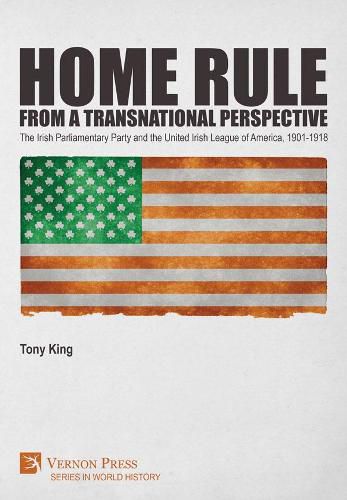Readings Newsletter
Become a Readings Member to make your shopping experience even easier.
Sign in or sign up for free!
You’re not far away from qualifying for FREE standard shipping within Australia
You’ve qualified for FREE standard shipping within Australia
The cart is loading…






This title is printed to order. This book may have been self-published. If so, we cannot guarantee the quality of the content. In the main most books will have gone through the editing process however some may not. We therefore suggest that you be aware of this before ordering this book. If in doubt check either the author or publisher’s details as we are unable to accept any returns unless they are faulty. Please contact us if you have any questions.
When John Redmond declared ‘No Irishman in America living 3,000 miles away from the homeland ought to think he has a right to dictate to Ireland’ the Irish leader unwittingly made a rod for his own back. In denying the newly-established United Irish League of America any input into party policy formulation, Redmond risked alienating the nation’s largest diaspora should a home rule crisis ever occur. That such a situation developed in 1914 is an established fact. That it was the product of Redmond’s own naivety is open to conjecture. ‘Home Rule from a Transnational Perspective: The Irish Parliamentary Party and the United Irish League of America, 1901-1918’ explores the Irish Party’s subordination of its American affiliate in light of the ultimate demise of constitutional nationalism in Ireland.
This book fills a void in Irish American studies. To date, research in this field has been dominated by Clan na Gael and the Irish Revolutionary Brotherhood, particularly the transatlantic links that underpinned the Easter Rising in 1916. Little attention has been paid to the Irish party’s efforts to manage the diaspora in the years preceding the insurrection or to the individuals and organisations that proffered a more moderate solution to the age-old Irish Question. Breaking new ground, it offers a fresh and interesting perspective on the fall of the Home Rule Party and helps to explain the seismic shift towards a more radical approach to gaining independence.
This book is essential reading for anyone interested in Irish America, diaspora studies, Irish independence, and/or home rule. It complements the existing historiography and enhances our knowledge of a largely understudied aspect of Irish nationalism.
$9.00 standard shipping within Australia
FREE standard shipping within Australia for orders over $100.00
Express & International shipping calculated at checkout
This title is printed to order. This book may have been self-published. If so, we cannot guarantee the quality of the content. In the main most books will have gone through the editing process however some may not. We therefore suggest that you be aware of this before ordering this book. If in doubt check either the author or publisher’s details as we are unable to accept any returns unless they are faulty. Please contact us if you have any questions.
When John Redmond declared ‘No Irishman in America living 3,000 miles away from the homeland ought to think he has a right to dictate to Ireland’ the Irish leader unwittingly made a rod for his own back. In denying the newly-established United Irish League of America any input into party policy formulation, Redmond risked alienating the nation’s largest diaspora should a home rule crisis ever occur. That such a situation developed in 1914 is an established fact. That it was the product of Redmond’s own naivety is open to conjecture. ‘Home Rule from a Transnational Perspective: The Irish Parliamentary Party and the United Irish League of America, 1901-1918’ explores the Irish Party’s subordination of its American affiliate in light of the ultimate demise of constitutional nationalism in Ireland.
This book fills a void in Irish American studies. To date, research in this field has been dominated by Clan na Gael and the Irish Revolutionary Brotherhood, particularly the transatlantic links that underpinned the Easter Rising in 1916. Little attention has been paid to the Irish party’s efforts to manage the diaspora in the years preceding the insurrection or to the individuals and organisations that proffered a more moderate solution to the age-old Irish Question. Breaking new ground, it offers a fresh and interesting perspective on the fall of the Home Rule Party and helps to explain the seismic shift towards a more radical approach to gaining independence.
This book is essential reading for anyone interested in Irish America, diaspora studies, Irish independence, and/or home rule. It complements the existing historiography and enhances our knowledge of a largely understudied aspect of Irish nationalism.